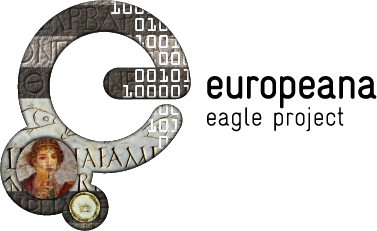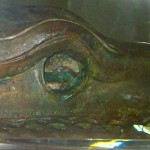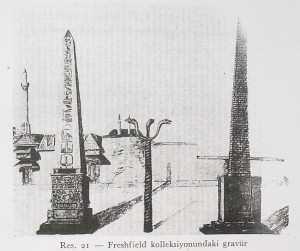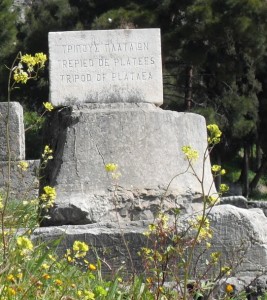Sulthanamet panorama
- Created at: 2007-12-27 20:28:07
- Description: Sulthanamet, Istanbul, by night. Panorama showing Hagia Sophia, the Hippodrome and the Blue Mosque
- Artist: Egil
- License: cc-by-3.0
Sulthanamet Square in Istanbul hosts part of one of the most important monuments survived from ancient times: the trophy of the battle of Platea.
Battle of Plataea
-
The Battle of Plataea was the final land battle during the second Persian invasion of Greece. It took place in 479 BC near the city of Plataea in Boeotia, and was fought between an alliance of the Greek city-states (including Sparta, Athens, Corinth and Megara), and the Achaemenid Empire of Xerxes I (allied with Greek states including Boeotia, Thessalia, and Macedon).
At the preceding Battle of Salamis, the allied Greek navy had won an unlikely but decisive victory, preventing the conquest of the Peloponnesus region. Xerxes then retreated with much of his army, leaving his general Mardonius to finish off the Greeks the following year. In the summer of 479 BC, the Greeks assembled a huge army and marched out of the Peloponnesus. The Persians retreated to Boeotia and built a fortified camp near Plataea. The Greeks, however, refused to be drawn into the prime terrain for cavalry around the Persian camp, resulting in a stalemate that lasted eleven days.
While attempting a retreat after their supply lines were disrupted, the Greek battle line fragmented. Thinking that the Greeks were in full retreat, Mardonius ordered his forces to pursue them, but the Greeks, particularly the Spartans, Tegeans and Athenians halted and gave battle, routing the lightly armed Persian infantry and killing Mardonius. A large portion of the Persian army was trapped in its camp and killed. The destruction of this army, and the remnants of the Persian navy allegedly on the same day at the Battle of Mycale, decisively ended the invasion.
Read Full Article
The part which is now in front of the Blue Mosque, is the column, while the base of the monument is still in Delphi.
Serpent Column (8394621182)
- Position: 41.005647 | 28.975119
- Created at: 2014-04-02 06:43:27
- Description: To raise the image of his new capital, Constantine and his successors, especially Theodosius the Great, brought works of art from all over the empire to adorn it. The monuments were set up in the middle of the Hippodrome, the spina. Among these was the Tripod of Plataea, now known as the Serpent Column, cast to celebrate the victory of the Greeks over the Persians during the Persian Wars in the 5th century BC. Constantine ordered the Tripod to be moved from the Temple of Apollo at Delphi, and set in middle of the Hippodrome. The top was adorned with a golden bowl supported by three serpent heads. The bowl was destroyed or stolen during the Fourth Crusade. The serpent heads were destroyed as late as the end of the 17th Century, as many Ottoman miniatures show they were intact in the early centuries following the Turkish conquest of the city. Parts of the heads were recovered and are displayed at the Istanbul Archaeology Museum. All that remains of the Delphi Tripod today is the base, known as the "Serpentine Column" [Wikipedia.org]
- Artist: Jorge Láscar from Australia
- License: cc-by-2.0
On this column there is a greek inscription, dated around 480 BCE, which lists the names of the cities taking part in the war against the Persian Empire. The column itself was in fact probably taken from the Persians as part of the booty of the battle and then dedicated in the panhellenic sanctuary. It was customary to gift to the gods a tenth of the booty and this column was part of this donation.
- no response to http://www.europeana.eu/api/v2/record/9200170/647C5FD16D6A6E04FF5AC4FF17AB8159BAA23868.json?wskey=ydRg6Ujho&profile=standard!
#0 /var/www/html/eagle/wp-content/plugins/eagle-storytelling/esa_datasource.class.php(222): esa_datasource\abstract_datasource->_fetch_external_data('http://www.euro...') #1 /var/www/html/eagle/wp-content/plugins/eagle-storytelling/esa_datasource.class.php(207): esa_datasource\abstract_datasource->_generic_api_call('http://www.euro...') #2 /var/www/html/eagle/wp-content/plugins/eagle-storytelling/esa_item.class.php(142): esa_datasource\abstract_datasource->get('/9200170/647C5F...') #3 /var/www/html/eagle/wp-content/plugins/eagle-storytelling/esa_item.class.php(63): esa_item->_generator() #4 /var/www/html/eagle/wp-content/plugins/eagle-storytelling/eagle-storytelling.php(703): esa_item->html(true) #5 /var/www/html/eagle/wp-includes/shortcodes.php(434): esa_shortcode(Array, '', 'esa') #6 [internal function]: do_shortcode_tag(Array) #7 /var/www/html/eagle/wp-includes/shortcodes.php(273): preg_replace_callback('/\\[(\\[?)(captio...', 'do_shortcode_ta...', '[esa source="co...') #8 /var/www/html/eagle/wp-includes/class-wp-hook.php(324): do_shortcode('[esa source="co...') #9 /var/www/html/eagle/wp-includes/plugin.php(205): WP_Hook->apply_filters('[esa source="co...', Array) #10 /var/www/html/eagle/wp-includes/post-template.php(256): apply_filters('the_content', '[esa source="co...') #11 /var/www/html/eagle/wp-content/plugins/eagle-storytelling-bridge/template/loop-single-story.php(38): the_content() #12 /var/www/html/eagle/wp-content/plugins/eagle-storytelling-bridge/template/single-story.php(9): include('/var/www/html/e...') #13 /var/www/html/eagle/wp-includes/template-loader.php(106): include('/var/www/html/e...') #14 /var/www/html/eagle/wp-blog-header.php(19): require_once('/var/www/html/e...') #15 /var/www/html/eagle/index.php(17): require('/var/www/html/e...') #16 {main}
The Persian wars had been won by the small Greek Cities in league against the overwhelming power of the Persian Empire and this was a collective achievement of unprecedented importance.
This column became a landmark because it marked a deed of such importance and probably also for this reason, Constantine decided at the beginning of the 4th century CE, almost a thousand years later to move it to his newly build capital of the Roman Empire, Constantinople. He took the column, but the base stayed there in Delphi.
- no response to http://gazetteer.dainst.org/search.json?q={%22bool%22:{%22must%22:%5B%20{%20%22match%22:%20{%20%22_id%22:%202282705%20}}%5D}}&type=extended!
#0 /var/www/html/eagle/wp-content/plugins/eagle-storytelling/esa_datasource.class.php(222): esa_datasource\abstract_datasource->_fetch_external_data('http://gazettee...') #1 /var/www/html/eagle/wp-content/plugins/eagle-storytelling/esa_datasource.class.php(207): esa_datasource\abstract_datasource->_generic_api_call('http://gazettee...') #2 /var/www/html/eagle/wp-content/plugins/eagle-storytelling/esa_item.class.php(142): esa_datasource\abstract_datasource->get('2282705') #3 /var/www/html/eagle/wp-content/plugins/eagle-storytelling/esa_item.class.php(63): esa_item->_generator() #4 /var/www/html/eagle/wp-content/plugins/eagle-storytelling/eagle-storytelling.php(703): esa_item->html(true) #5 /var/www/html/eagle/wp-includes/shortcodes.php(434): esa_shortcode(Array, '', 'esa') #6 [internal function]: do_shortcode_tag(Array) #7 /var/www/html/eagle/wp-includes/shortcodes.php(273): preg_replace_callback('/\\[(\\[?)(captio...', 'do_shortcode_ta...', '[esa source="co...') #8 /var/www/html/eagle/wp-includes/class-wp-hook.php(324): do_shortcode('[esa source="co...') #9 /var/www/html/eagle/wp-includes/plugin.php(205): WP_Hook->apply_filters('[esa source="co...', Array) #10 /var/www/html/eagle/wp-includes/post-template.php(256): apply_filters('the_content', '[esa source="co...') #11 /var/www/html/eagle/wp-content/plugins/eagle-storytelling-bridge/template/loop-single-story.php(38): the_content() #12 /var/www/html/eagle/wp-content/plugins/eagle-storytelling-bridge/template/single-story.php(9): include('/var/www/html/e...') #13 /var/www/html/eagle/wp-includes/template-loader.php(106): include('/var/www/html/e...') #14 /var/www/html/eagle/wp-blog-header.php(19): require_once('/var/www/html/e...') #15 /var/www/html/eagle/index.php(17): require('/var/www/html/e...') #16 {main}
In Constantinople the column was placed in the hippodrome, a place of extreme importance for the city.
Later on, probably just after 1700, the three snake heads where removed during the night from a group of drunk soldiers.
What we now have is the column shaft, but we don’t know what the trophy looked like through ages in the different phases of its history. We have some images from ancient books in which the column is represented and we know that it had three snake heads, one of which was probably found during excavations.
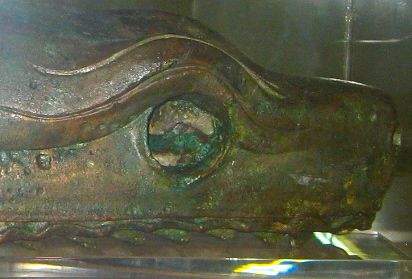 Archeologists and historians have tried to give several possible hypothesis for the first shape of this monument, based on the information we have from ancient sources. One possibility is that the three heads held a large vase on top of them, or alternatively three long legs could be holding on the top part and the column would have been only a central stand, as in a typical Delphic tripod. We will probably never know.
Archeologists and historians have tried to give several possible hypothesis for the first shape of this monument, based on the information we have from ancient sources. One possibility is that the three heads held a large vase on top of them, or alternatively three long legs could be holding on the top part and the column would have been only a central stand, as in a typical Delphic tripod. We will probably never know.
Orestes Delphi BM GR1917.12-10.1
- Created at: 2006-12-16 09:57:37
- Artist: Python (as painter)
- Description: Orestes at Delphi. Paestan red-figured bell-krater, ca. 330 BC.
- License: pd
Moreover, the base which was in a first time thought to be the one on which the column stood was not the right one, and it is much more likely, as scholars demonstrated that another base, found in Delphi, held the column.
The so called Serpentine column continued to have a role in history during the Byzantine and Ottoman periods and was a fountain as well as a magical monument keeping snakes out of the city.
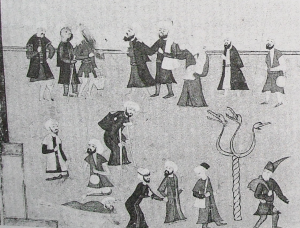 The number of problems opened by this monument are many, as the problems opened by the list of names on the column.
The number of problems opened by this monument are many, as the problems opened by the list of names on the column.
The history of a monument with its inscription can be extremely long and complex and this example is one for which we have quite a lot of evidence from which we can figure out good questions and plausible solutions.
- no response to http://www.europeana.eu/api/v2/record/2055734/item_php_view_54280.json?wskey=ydRg6Ujho&profile=standard!
#0 /var/www/html/eagle/wp-content/plugins/eagle-storytelling/esa_datasource.class.php(222): esa_datasource\abstract_datasource->_fetch_external_data('http://www.euro...') #1 /var/www/html/eagle/wp-content/plugins/eagle-storytelling/esa_datasource.class.php(207): esa_datasource\abstract_datasource->_generic_api_call('http://www.euro...') #2 /var/www/html/eagle/wp-content/plugins/eagle-storytelling/esa_item.class.php(142): esa_datasource\abstract_datasource->get('/2055734/item_p...') #3 /var/www/html/eagle/wp-content/plugins/eagle-storytelling/esa_item.class.php(63): esa_item->_generator() #4 /var/www/html/eagle/wp-content/plugins/eagle-storytelling/eagle-storytelling.php(703): esa_item->html(true) #5 /var/www/html/eagle/wp-includes/shortcodes.php(434): esa_shortcode(Array, '', 'esa') #6 [internal function]: do_shortcode_tag(Array) #7 /var/www/html/eagle/wp-includes/shortcodes.php(273): preg_replace_callback('/\\[(\\[?)(captio...', 'do_shortcode_ta...', '[esa source="co...') #8 /var/www/html/eagle/wp-includes/class-wp-hook.php(324): do_shortcode('[esa source="co...') #9 /var/www/html/eagle/wp-includes/plugin.php(205): WP_Hook->apply_filters('[esa source="co...', Array) #10 /var/www/html/eagle/wp-includes/post-template.php(256): apply_filters('the_content', '[esa source="co...') #11 /var/www/html/eagle/wp-content/plugins/eagle-storytelling-bridge/template/loop-single-story.php(38): the_content() #12 /var/www/html/eagle/wp-content/plugins/eagle-storytelling-bridge/template/single-story.php(9): include('/var/www/html/e...') #13 /var/www/html/eagle/wp-includes/template-loader.php(106): include('/var/www/html/e...') #14 /var/www/html/eagle/wp-blog-header.php(19): require_once('/var/www/html/e...') #15 /var/www/html/eagle/index.php(17): require('/var/www/html/e...') #16 {main}
